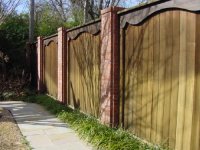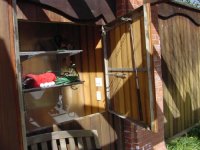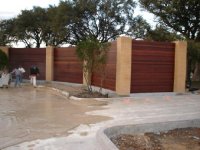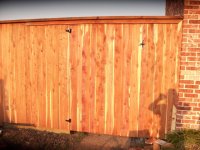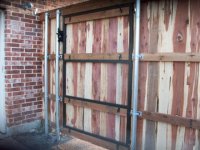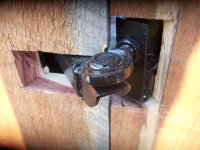Eight years and more than a couple of face to faces and I've finally found something to disagree with Bird about.
I like the grey.
My fence has never been treated and it's seventeen plus years old. It's western red cedar. It's a little like me, crusty with character and still able to do what it's supposed to do and look good doing it.
I build fences on occasion. This is what I know. First the treated wood is for marketing. Second is wood rots first from the end grain. So you protect the end grain and you delay the rot. I always run a two by on top of the fence. It provides strength for the fence because it gives it lateral strength. It also protects the end grain. I try to keep the bottom of the pickets off the dirt and use a skirt rail I guess you would call it.
If you want a fence that will last forever consider a teak one. I built one at a golf course in Ft Worth made of massanadaruba, it's like epay. It's an ironwood, won't float, really, sinks like a brick. The next best material is cypress. Then comes the cedars. I just built one a year or so ago where I used eastern red cedar. It was gorgeous until the client stained it. Now it looks like western red cedar and everyone else's stained fence.
Bird's right about the builder's fences. They're terrible. A subdivision near my house was put in with landscape timbers and prefabbed white wood panels. The pickets were three eighths of an inch thick. Five years later the posts are rotting and breaking. The pickets are bowing and breaking too.
If you're going to use treated lumber there's a couple of things you need to consider. First is you need to accept that it's really about marketing, sorry. Even more importantly you need to go against human nature when choosing your material. We naturally equate weight to value for the most part. That is the worst thing to do when choosing treated lumber.
The reason is water is what's giving you the weight. You want the lightest boards available because you want as little of the water as you can get. The reason is for the most part they treat the worst grades. When the wood dries then it goes wherever the grain and cut direct it. Wet the boards look great and straight. When they dry then they bow and cup and split etc and so on.
Most of the cities in north Texas won't allow wood posts period for wood fences. That's because wood rots and breaks so easily when it's the wrong kind of wood to be used for fence posts. You have to use galvanized pipe, well, at least it looks like galvanized pipe for posts. You can't buy real pipe posts at any of the box stores anymore. The cost is so high and yet it's cheap when you look at what you get and what it costs to replace a piece of muffler tubing sold as a fence post.
The only one who is going to tell you to immediately seal your fence is the person selling sealer.
The first couple of pictures are of a western red cedar fence with a hidden locker installed.
The next ones are of the massanadaruba fence.
The last ones are of an eastern red cedar and some gate details.
